An uncontrolled satellite is seen tumbling towards Earth in newly released images as it prepares to reenter the atmosphere.
ERS-2 was launched almost 30 years ago and is expected to break up into pieces upon reentry into the the Earth’s atmosphere.
Experts from the European Space Agency said the ERS-2 will break up into fragments around 80 km above the Earth’s surface and the vast majority of these will burn up in the atmosphere.
But some fragments could reach Earth’s surface.
The UK Space Agency captured images of ERS-2 during its descent. The satellite is falling by more than 10 km a day and the speed of its descent is increasing rapidly. It is expected to reenter the Earth’s atmosphere on Wednesday.
What is the ERS-2?
The ERS-2 was launched back in 1995 and was the most sophisticated satellite ever developed by Europe.
It collected a trove of information on land surfaces, oceans and polar caps and analysed natural disasters.
When did its mission end?
After 16 years of successful operations the European Space Agency took the decision to end its mission and deorbit the satellite.
A number of space manoeuvres were then made to reduce its risk of colliding with other satellites before it eventually reentered the Earth’s atmosphere.
The ESA estimates the satellite will reenter Earth’s atmosphere at 11:14 GMT on Wednesday, February 21.
Where will the satellite crash?
The satellite is under frequent observation by the ESA but because the reentry is ‘natural’, it is impossible to predict exactly when and where the satellite will begin to burn up.
The window during which reentry is possible will continue to shrink until the time of reentry, they said.
ESA’s Space Debris Office is frequently updating its prediction for where and when ERS-2 will reenter the atmosphere and begin to burn up.
The ESA said: “Some fragments could reach Earth’s surface, where they will most likely fall into the ocean. None of these fragments will contain any toxic or radioactive substances.”
What is the risk of being hit by falling debris?
Despite the fact that experts can’t predict where parts of the satellite will hit the Earth, the annual risk of an individual human being injured by space debris is under 1 in 100 billion.
That is:
-
1.5 million times lower than the risk of being killed in an accident at home
-
65,000 times lower than the risk of being struck by lightning
-
three times lower than the risk of being struck by a meteorite
None of the fragments that could hit the Earth contain any toxic or radioactive substances, the ESA said.
Source: https://www.itv.com/news/2024-02-19/satellite-to-make-fiery-atmosphere-reentry-as-it-hurtles-towards-earth



